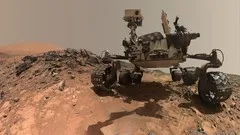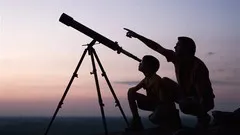
Robotic Space Exploration 
Get a comprehesive understanding of Robotic Space Exploration. This is a pay course from Udemy. AZ Class provides this course data for free. Learn more certificate and details here. Discover the fascinating world of Robotic Space Exploration! This course takes you on a thrilling journey through the solar system, exploring the incredible achievements of space robots. Unlike humans, these robots can endure extreme conditions and travel at unimaginable speeds. They have made unexpected discoveries and expanded their understanding of the universe. With bonus lessons on astronomy, eclipses, meteor showers, and auroras, this course offers a comprehensive exploration of space. From orbiters and rovers to landers and observatories, you'll learn about the different types of robotic missions and their applications. Don't miss out on this out-of-this-world adventure! ▼
ADVERTISEMENT
Course Feature
![]() Cost:
Cost:
Paid
![]() Provider:
Provider:
Udemy
![]() Certificate:
Certificate:
Paid Certification
![]() Language:
Language:
English
![]() Start Date:
Start Date:
2021-11-07
Course Overview
❗The content presented here is sourced directly from Udemy platform. For comprehensive course details, including enrollment information, simply click on the 'Go to class' link on our website.
Updated in [October 07th, 2023]
What does this course tell?
(Please note that the following overview content is from the original platform)
We are inspired by human space exploration but these space robots can go places humans could never go : and for longer periods of time Much of the exploration we've accomplished in the solar system is because of our ability to make robots and send them to explore They travel as speeds humans could not endure they don't need water heat or food and they don't need to be entertained - they just work Explore the many different kinds of robot emissaries we've sent into the solar system and what unexpected discoveries they've made for usThis Course includes the following great BONUS LESSONS:What on Earth is Astronomy?Mini-Lesson: EclipsesMini-Lesson: Meteor ShowersMini-Lesson: AuroraRobotic Space Exploration1 Objective2 Warm-up activities3 Glossary of terms4 Definition and characteristics of robotic exploring5 Robots in society and popular culture6 Advantages and disadvantages of space exploration using robotic craft7 Comparing and contrasting human and robotic spacecraft and exploration8 The dangers and challenges of manned space flight9 Why we explore10 Current robotic missions throughout the Solar SystemTypes of robotic missions and their applications in the Solar System11 Multistage rockets12 The space shuttleFlyby13 Fuel savings14 Chinese Moon observations15 Studying cometsOrbiters16 Long-term observations of Mars including the Reconnaissance Orbiter17 Deceleration using air breaking and the first law of motion18 Long-term power from the Sun and power storage19 Communicating over large distances20 Cassini orbiter around SaturnLanders21 Landing techniques and challenges using rockets airbags and parachutes22 Early Venus landings by the Soviet's Venera23 Venus Express24 Early Moon landers: Luna and Ranger25 Landing on a comet: the Philae landerRovers26 Entry decent and landing27 Landers delivering rovers28 Sojourner and Opportunity rovers on Mars29 Distance limits self-maintenance energy and communication techniques30 Escaping from the landers after deliveryPenetrators31 Penetrator form and function32 Moon penetrator LCROSS looking for water33 Martian penetratorsObservatories34 Earth and Sun orbiting craft including the Hubble Space Telescope and Spitzer35 Advantages and disadvantages of observatories orbiting the Sun and EarthCommunication Craft36 Primary functions37 Deep-space communication systems and Solar System explorationAtmospheric Craft38 Function of atmospheric crafts39 Atmospheric studies done on Jupiter Venus Mars and Saturn's moon Titan40 Detailed explanation of Huygens probe on Titan41 Multiple-category crafts42 Terrestrial planetsMercury43 Brief description of Mercury44 History of crafts to Mercury including Mariner series45 Current crafts studying the planet46 Future missions to Mercury including BepiColomboVenus47 Brief description of Venus48 History of crafts to Venus including Venera and Mariner series49 Future missions to VenusMars50 Brief description of Mars51 History of crafts to Mars52 Communication delays with robots on Mars53 Current crafts studying the planet and their durations54 Future missions to Mars55 Space travel using the [Gravity Assist] method : description of the physics and practical application56 Crafts leaving the Solar System: Voyager and Pioneer series57 Test questions58 Cross-curricular activities
We considered the value of this course from many aspects, and finally summarized it for you from two aspects: skills and knowledge, and the people who benefit from it:
(Please note that our content is optimized through artificial intelligence tools and carefully reviewed by our editorial staff.)
What skills and knowledge will you acquire during this course?
During this course on Robotic Space Exploration, learners will acquire the following skills and knowledge:
1. Objective: Understand the purpose and goals of robotic space exploration.
2. Warm-up activities: Engage in activities to stimulate interest and prepare for the course.
3. Glossary of terms: Learn and understand the key vocabulary related to robotic space exploration.
4. Definition and characteristics of robotic exploring: Understand the nature and features of robotic exploration.
5. Robots in society and popular culture: Explore the role of robots in society and their portrayal in popular culture.
6. Advantages and disadvantages of space exploration using robotic craft: Analyze the benefits and drawbacks of using robots for space exploration.
7. Comparing and contrasting human and robotic spacecraft and exploration: Compare the capabilities and limitations of human and robotic spacecraft.
8. The dangers and challenges of manned space flight: Understand the risks and difficulties associated with human space travel.
9. Why we explore: Explore the motivations and reasons behind space exploration.
10. Current robotic missions throughout the Solar System: Study the ongoing robotic missions in different parts of the Solar System.
Types of robotic missions and their applications in the Solar System:
11. Multistage rockets: Learn about the design and functioning of multistage rockets.
12. The space shuttle: Understand the purpose and operations of the space shuttle.
13. Flyby: Study the concept of flyby missions and their significance.
14. Fuel savings: Explore the techniques used to save fuel during space missions.
15. Chinese Moon observations: Learn about the Chinese missions to observe the Moon.
16. Studying comets: Understand the methods and objectives of studying comets.
17. Orbiters: Study the role and functions of orbiters, with a focus on the Mars Reconnaissance Orbiter.
18. Deceleration using air breaking and the first law of motion: Learn about deceleration techniques and the laws of motion involved.
19. Long-term power from the Sun and power storage: Understand the use of solar power and energy storage in long-term missions.
20. Communicating over large distances: Explore the challenges and solutions for communication over vast distances.
21. Cassini orbiter around Saturn: Study the Cassini mission and its findings.
Landers:
22. Landing techniques and challenges using rockets, airbags, and parachutes: Understand the different landing methods and the challenges they pose.
23. Early Venus landings by the Soviet's Venera: Learn about the early Soviet missions to land on Venus.
24. Venus Express: Study the Venus Express mission and its objectives.
25. Early Moon landers: Luna and Ranger: Explore the early missions to land on the Moon.
26. Landing on a comet: the Philae lander: Understand the challenges and achievements of landing on a comet.
Rovers:
27. Entry, descent, and landing: Learn about the process of entering a planet's atmosphere and landing safely.
28. Landers delivering rovers: Understand the role of landers in delivering rovers to planetary surfaces.
29. Sojourner and Opportunity rovers on Mars: Study the missions and discoveries of the Sojourner and Opportunity rovers on Mars.
30. Distance limits, self-maintenance, energy, and communication techniques: Explore the limitations and solutions for long-distance rovers.
Penetrators:
31. Penetrator form and function: Understand the design and purpose of penetrators.
32. Moon penetrator LCROSS looking for water: Study the LCROSS mission to search for water on the Moon.
33. Martian penetrators: Learn about the missions involving penetrators on Mars.
Observatories:
34. Earth and Sun orbiting craft including the Hubble Space Telescope and Spitzer: Explore the role and capabilities of observatories orbiting the Earth and Sun.
35. Advantages and disadvantages of observatories orbiting the Sun and Earth: Analyze the benefits and drawbacks of observatories in different orbits.
Communication Craft:
36. Primary functions: Understand the primary functions of communication craft in space exploration.
37. Deep-space communication systems and Solar System exploration: Study the communication systems used for deep-space missions.
Atmospheric Craft:
38. Function of atmospheric crafts: Learn about the purpose and functions of atmospheric crafts.
39. Atmospheric studies done on Jupiter, Venus, Mars, and Saturn's moon Titan: Explore the atmospheric studies conducted on different celestial bodies.
40. Detailed explanation of Huygens probe on Titan: Study the Huygens probe mission and its findings.
41. Multiple-category crafts: Understand the different categories of spacecraft used for various purposes.
Terrestrial planets:
42. Brief description of Mercury: Learn about the characteristics of the planet Mercury.
43. History of crafts to Mercury including Mariner series: Study the historical missions to Mercury, including the Mariner series.
44. Current crafts studying the planet: Explore the ongoing missions to study Mercury.
45. Future missions to Mercury including BepiColombo: Understand the planned future missions to Mercury, including the BepiColombo mission.
Venus:
46. Brief description of Venus: Learn about the characteristics of the planet Venus.
47. History of crafts to Venus including Venera and Mariner series: Study the historical missions to Venus, including the Venera and Mariner series.
48. Future missions to Venus: Explore the planned future missions to Venus.
Mars:
49. Brief description of Mars: Learn about the characteristics of the planet Mars.
50. History of crafts to Mars: Study the historical missions to Mars.
51. Communication delays with robots on Mars: Understand the challenges and solutions for communication with robots on Mars.
52. Current crafts studying the planet and their durations: Explore the ongoing missions to study Mars and their durations.
53. Future missions to Mars: Understand the planned future missions to Mars.
54. Space travel using the Gravity Assist method: Learn about the physics and practical application of the Gravity Assist method.
55. Crafts leaving the Solar System: Voyager and Pioneer series: Study the missions of the Voyager and Pioneer spacecraft that have left the Solar System.
Test questions: Assess the understanding of the course material through test questions.
Cross-curricular activities: Engage in activities that integrate knowledge from different subjects.
By completing this course, learners will have a comprehensive understanding of robotic space exploration, including the different types of missions, their applications, and the challenges involved.
Who will benefit from this course?
This course on Robotic Space Exploration will benefit individuals who are interested in astronomy, space exploration, and robotics. It is particularly relevant for the following professions:
1. Astronomers: This course provides a comprehensive understanding of the different types of robotic missions and observatories used in space exploration. Astronomers can gain insights into the capabilities and limitations of these robotic emissaries, which can aid in their research and observations.
2. Space Scientists: Professionals working in the field of space science will benefit from this course as it covers various aspects of robotic exploration, including the advantages and disadvantages of using robotic craft, the challenges of manned space flight, and the current robotic missions throughout the Solar System. This knowledge can enhance their understanding of space exploration and inform their research.
3. Engineers: Engineers involved in the design and development of robotic spacecraft will find this course valuable. It covers topics such as landing techniques, communication systems, power storage, and the function of atmospheric crafts. The course provides insights into the technical aspects of robotic space exploration, which can aid engineers in their work.
4. Educators: Teachers and educators who want to incorporate space exploration and robotics into their curriculum can benefit from this course. It includes bonus lessons on astronomy, eclipses, meteor showers, and auroras, which can be used to enhance students' understanding of these topics. The course also offers test questions and cross-curricular activities, providing educators with resources to engage their students.
5. Space Enthusiasts: Individuals with a general interest in space exploration and robotics will find this course fascinating. It delves into the history of robotic missions to different celestial bodies, including Mercury, Venus, Mars, and the outer planets. It also explores the unexpected discoveries made by these robotic emissaries, making it an engaging and informative course for space enthusiasts.
Course Syllabus
Introduction
Main Lesson: Robotic Space Exploration
Glossary, Testing & Answer Key
Activities and Resources
Standards and Dedications
Bonus Lesson: What on Earth is Astronomy
Bonus Lesson: Eclipse
Bonus Mini Lesson - Meteor Showers
Bonus Mini Lesson - Aurora
Course Provider

Provider Udemy's Stats at AZClass
Discussion and Reviews
0.0 (Based on 0 reviews)
Explore Similar Online Courses

How to REALLY use a Telescope

Greatest Unsolved Mysteries In The Universe

Python for Informatics: Exploring Information

Social Network Analysis

Introduction to Systematic Review and Meta-Analysis

The Analytics Edge

DCO042 - Python For Informatics

Causal Diagrams: Draw Your Assumptions Before Your Conclusions

Whole genome sequencing of bacterial genomes - tools and applications

Astronomy: Eclipses Prediction

Astronomy: Exploring the solar system


Start your review of Robotic Space Exploration